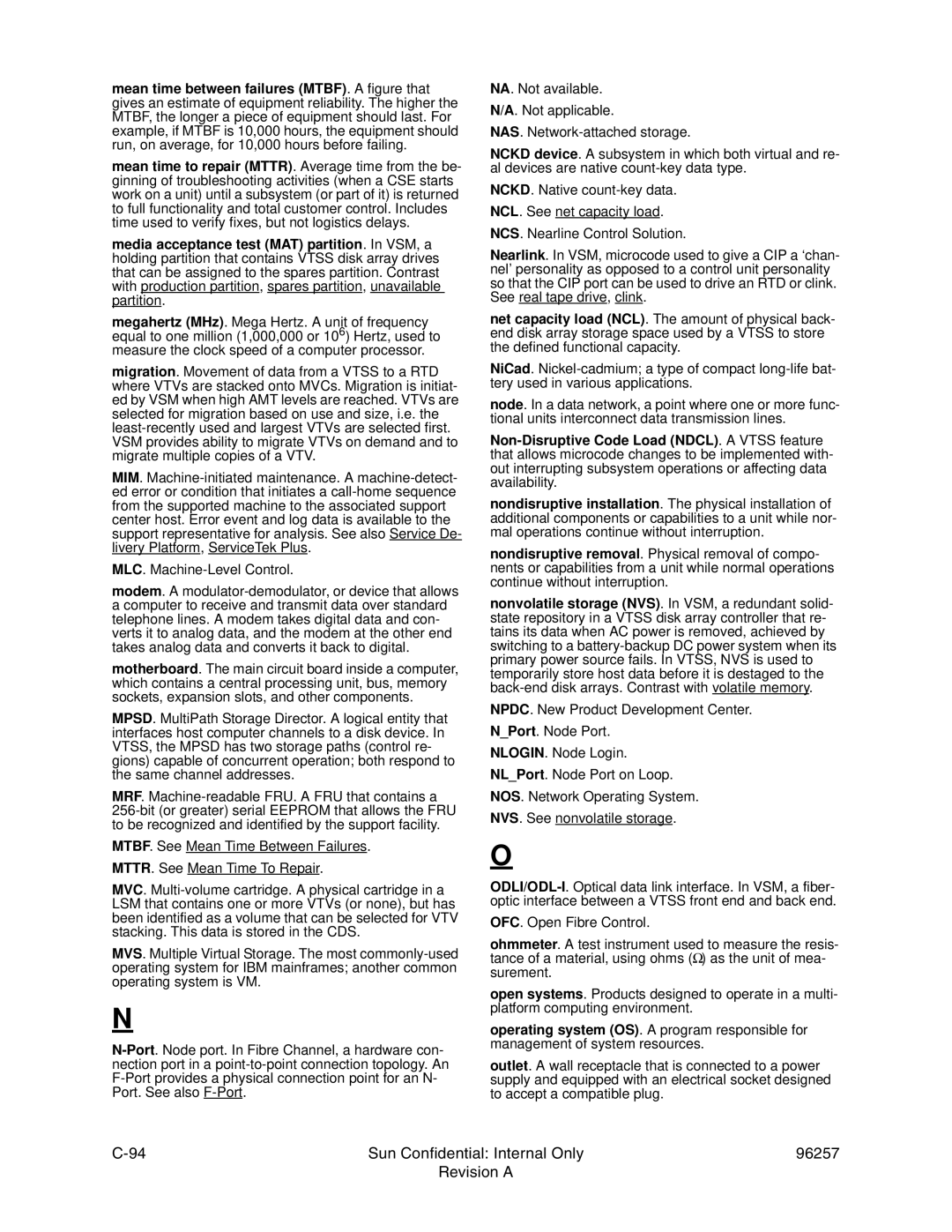mean time between failures (MTBF). A figure that gives an estimate of equipment reliability. The higher the MTBF, the longer a piece of equipment should last. For example, if MTBF is 10,000 hours, the equipment should run, on average, for 10,000 hours before failing.
mean time to repair (MTTR). Average time from the be- ginning of troubleshooting activities (when a CSE starts work on a unit) until a subsystem (or part of it) is returned to full functionality and total customer control. Includes time used to verify fixes, but not logistics delays.
media acceptance test (MAT) partition. In VSM, a holding partition that contains VTSS disk array drives that can be assigned to the spares partition. Contrast with production partition, spares partition, unavailable partition.
megahertz (MHz). Mega Hertz. A unit of frequency equal to one million (1,000,000 or 106) Hertz, used to measure the clock speed of a computer processor.
migration. Movement of data from a VTSS to a RTD where VTVs are stacked onto MVCs. Migration is initiat- ed by VSM when high AMT levels are reached. VTVs are selected for migration based on use and size, i.e. the
MIM.
MLC. Machine-Level Control.
modem. A
motherboard. The main circuit board inside a computer, which contains a central processing unit, bus, memory sockets, expansion slots, and other components.
MPSD. MultiPath Storage Director. A logical entity that interfaces host computer channels to a disk device. In VTSS, the MPSD has two storage paths (control re- gions) capable of concurrent operation; both respond to the same channel addresses.
MRF.
MTBF. See Mean Time Between Failures.
MTTR. See Mean Time To Repair.
MVC.
MVS. Multiple Virtual Storage. The most
N
NA. Not available. N/A. Not applicable.
NAS.
NCKD device. A subsystem in which both virtual and re- al devices are native
NCKD. Native
NCL. See net capacity load.
NCS. Nearline Control Solution.
Nearlink. In VSM, microcode used to give a CIP a ‘chan- nel’ personality as opposed to a control unit personality so that the CIP port can be used to drive an RTD or clink. See real tape drive, clink.
net capacity load (NCL). The amount of physical back- end disk array storage space used by a VTSS to store the defined functional capacity.
NiCad.
node. In a data network, a point where one or more func- tional units interconnect data transmission lines.
nondisruptive installation. The physical installation of additional components or capabilities to a unit while nor- mal operations continue without interruption.
nondisruptive removal. Physical removal of compo- nents or capabilities from a unit while normal operations continue without interruption.
nonvolatile storage (NVS). In VSM, a redundant solid- state repository in a VTSS disk array controller that re- tains its data when AC power is removed, achieved by switching to a
NPDC. New Product Development Center. N_Port. Node Port.
NLOGIN. Node Login.
NL_Port. Node Port on Loop. NOS. Network Operating System.
NVS. See nonvolatile storage.
O
OFC. Open Fibre Control.
ohmmeter. A test instrument used to measure the resis- tance of a material, using ohms (Ω) as the unit of mea- surement.
open systems. Products designed to operate in a multi- platform computing environment.
operating system (OS). A program responsible for management of system resources.
outlet. A wall receptacle that is connected to a power supply and equipped with an electrical socket designed to accept a compatible plug.
Sun Confidential: Internal Only | 96257 | |
| Revision A |
|
